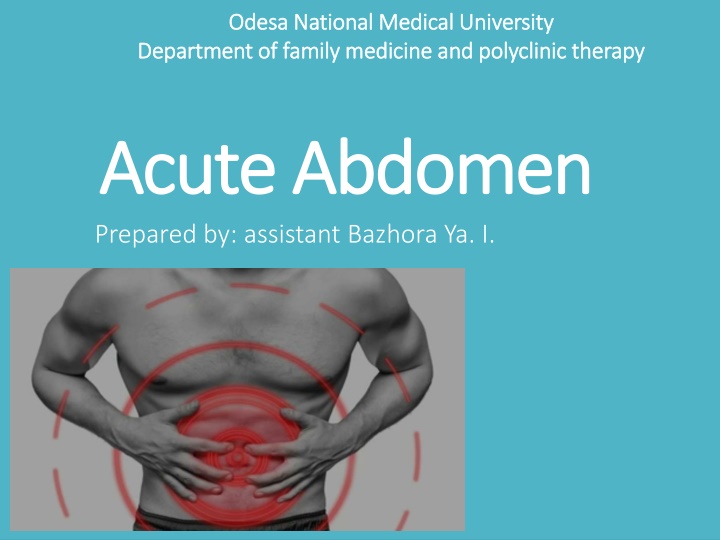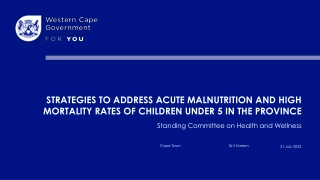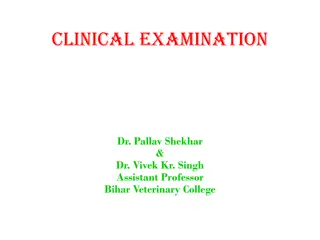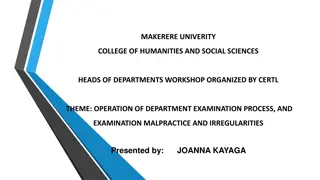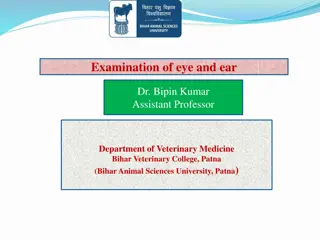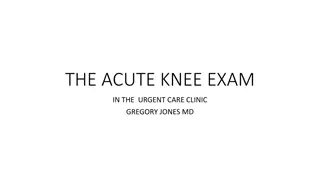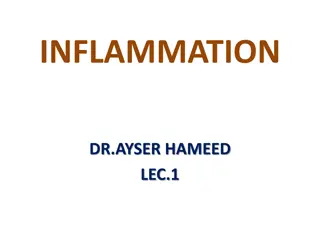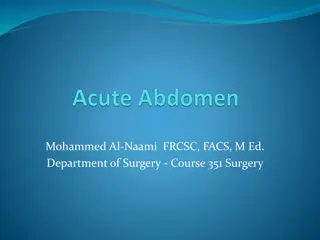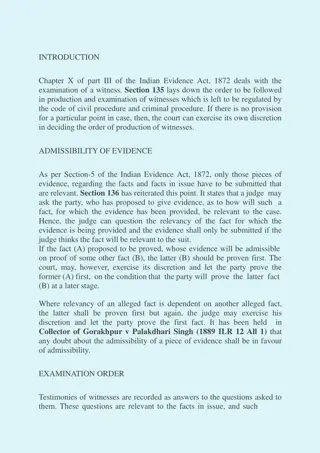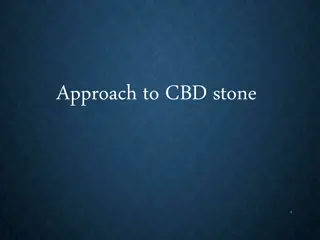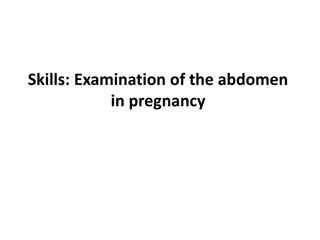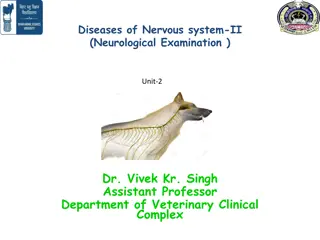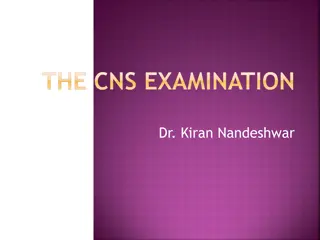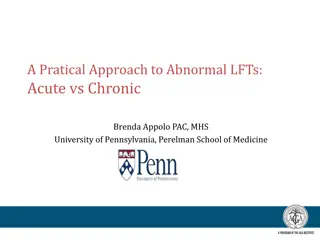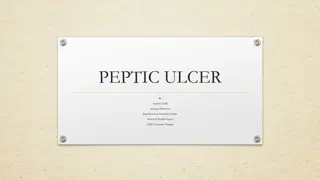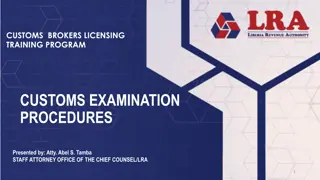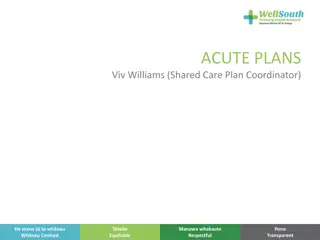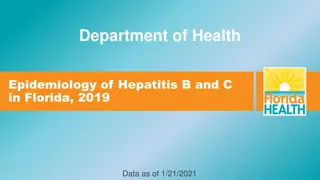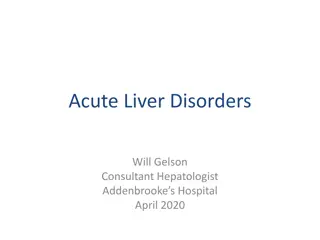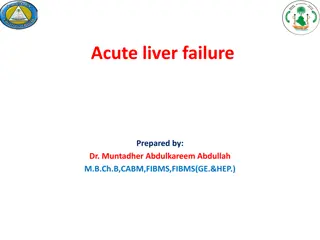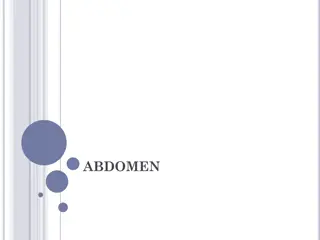Acute Abdomen: Causes, Symptoms, and Examination
Acute abdomen refers to the sudden onset of abdominal pain, often indicating a surgical emergency. This condition can have various causes such as intestinal issues, hepatobiliary conditions, vascular problems, urological and gynecological issues, and more. Recognizing the location and characteristics of the pain, associated symptoms, and conducting a thorough examination are crucial for accurate diagnosis and timely intervention.
Uploaded on Oct 02, 2024 | 2 Views
Download Presentation

Please find below an Image/Link to download the presentation.
The content on the website is provided AS IS for your information and personal use only. It may not be sold, licensed, or shared on other websites without obtaining consent from the author.If you encounter any issues during the download, it is possible that the publisher has removed the file from their server.
You are allowed to download the files provided on this website for personal or commercial use, subject to the condition that they are used lawfully. All files are the property of their respective owners.
The content on the website is provided AS IS for your information and personal use only. It may not be sold, licensed, or shared on other websites without obtaining consent from the author.
E N D
Presentation Transcript
Odesa National Medical University Odesa National Medical University Department of family medicine and polyclinic therapy Department of family medicine and polyclinic therapy Acute Abdomen Acute Abdomen Prepared by: assistant Bazhora Ya. I.
Acute abdomen, which is in many cases a surgical emergency, is the sudden onset of abdominal pain that may be caused by inflammatio, infection, perforation, ischemia, or obstruction. The location of the pain, its characteristics, and associated symptoms (e.g., jaundice) are important tools that help narrow the differential diagnosis. Patients will typically have severe tenderness with associated rigidity and rebound tenderness
Causes of Acute Abdomen Intestinal Acute appendicitis Acute appendicitis, mesenteric adenitis, mekel s diverticulitis, perforated peptic ulcer gastroenteritis, diverticulitis, intestinal obstruction diverticulitis, intestinal obstruction, strangulated hernia perforated peptic ulcer, strangulated hernia Hepatobiliary Biliary Biliary colic, colic, cholecystitis cholecystitis, , cholangitis cholangitis, pancreatitis , pancreatitis, hepatitis Vascular Ruptured AAA, acute mesenteric Ruptured AAA, acute mesenteric ischaemia ischaemia, , ischaemic ischaemic colitis colitis Urological Renal colic, UTI, testicular torsion, acute urinary retention Gynaecological Ectopic pregnancy, ovarian cyst pathology (rupture/haemorrhage into cyst/torsion), salpingitis, endometriosis, mittelschmerz (mid-cycle pain) Medical (can mimic an acute abdomen) Pneumonia, MI, DKA, sickle cell crisis, porphyria
Acute Abdomen: The Examination Liver (hepatitis) Gall bladder (gallstones) Stomach (peptic ulcer, gastritis) Transverse colon (cancer) Pancreas (pancreatitis) Heart (MI) Liver (hepatitis) Spleen (rupture) Pancreas (pancreatitis) Gall bladder (gallstones) Stomach (peptic ulcer) Splenic flexure colon (cancer) Stomach (peptic ulcer, gastritis) Lung (pneumonia) Hepatic flexure colon (cancer) Lung (pneumonia) Descending colon (cancer) Kidney (stone, hydronephrosis, UTI) Ascending colon (cancer,) Kidney (stone, hydronephrosis, UTI) Appendix (Appendicitis) Caecum (tumour, volvulus, closed loop obstruction) Terminal ileum (crohns, mekels) Ovaries/fallopian tube (ectopic, cyst, PID) Ureter (renal colic) Sigmoid colon (diverticulitis, colitis, cancer) Ovaries/fallopian tube (ectopic, cyst, PID) Ureter (renal colic) Small bowel (obstruction/ischaemia) Aorta (leaking AAA) Uterus (fibroid, cancer) Bladder (UTI, stone) Sigmoid colon (diverticulitis)
Intestinal PU PU: H.pylori, NSAIDs, steroids, >55, M, alcohol, bloating, epigastric/retrosternal pain, worse with food, GI bleed Gastric Gastric Ca nigricans Ca: Wt loss, smoking, blood grp A, GI bleed, epigastric pain, virchow s node, acanthosis Hiatus Hiatus hernia hernia: F, obese, >55, GORD, epigastric, N+V high DU DU: epigastric pain, improves with food, worse at night Chrohns Chrohns: transmural = air in abdomen, apthous ulcers, anal fissures, smoking, terminal ileum, younger, PR bleed UC UC: non-smoker, PSC, large bowel, PR bleed, lead pipe, nodosum IBS IBS: : Distension, bloating, generalised pain, improves with defacation, >45, F, stress, change in habit, diarrhoea Coeliac: Coeliac: steatorrhoea, diarrhoea, dermatitis herpetiformis, anaemia
Intestinal (Large Bowel) Appendicitis Appendicitis: RIF pain, Mc Burney s point tenderness, peritonitic Diverticulitis Diverticulitis: LIF pain, PR bleed, Elderly, common Colorectal Ca Colorectal Ca: Fe deficient anaemia, Wt loss, altered bowel habit, PR bleed, fatigue, mass palpable, obstructed Large bowel obstruction Large bowel obstruction: Distension, colicky pain, absolute constipation, N+V (faeculent), tinkling BS Small bowel obstruction Small bowel obstruction: early billious vomiting, late obstruction,chrohns Perforation Perforation: shock, rigid abdomen, severe tenderness, pyrexia, air under diaphragm, Rigler s sign
Hepatobilliary Biliary Colic Biliary Colic: constant, writhing, RUQ pain radiating to back, worsens with fatty meals Cholecystitis Cholecystitis: female, obese, >40, pregnant, RUQ pain radiating to shoulder blade, amylase, Murphy s sign Acute Pancreatitis Acute Pancreatitis: gallstones, alcohol, grey turners/cullens sign, RUQ pain radiating to back, improved by leaning forward, amylase Cholangitis Cholangitis: Fever ~40, Jaundice, RUQ pain, rigors, female, obese, gallstones Cirrhosis Cirrhosis: Jaundice, splenomegaly, telangectasia, spider naevi, high JVP, duputren s contractures, clubbing, palmer erythema, gynaecomastia, ascites, liver flap, xanthelasma, high INR, low Albumin
Vascular AAA: severe central pain, back pain, collapse, expansile abdominal mass, >50, smoker, HTN, marfan s, renal failure/colic, M Dissection: tearing retrosternal pain radiating to back, high BP, reduced leg pulses, renal involvement Mesenteric ischaemia: severe colicy generalised pain, reduced bowel sounds, air in intestinal walls, AF, elderly, angina MI: central, crushing pain, N+V, unstable, elderly, exertional, pale, SOB
GU UTI UTI: female, common, suprapubic tenderness, positive dip, retention, prolapse, DM Urinary Retention Urinary Retention: UTI, post-op, spinal injury, elderly, stones, severe constant suprapubic pain, well localised, resonant to percussion Renal colic Renal colic: sudden very severe loin to groin pain, tachycardic, pyrexia, sweating, writhing Testicular Torsion Testicular Torsion: Severe sudden lower abdo pain with unilateral groin tenderness and swelling, young
OBG Ectopic Ectopic: young, amennorrhoea, collapse, shock, severe sudden lower abdo pain radiating to shoulder, PV bleed PID PID: fertile, previous surgery, previous STI, purulent discharge, pyrexia Endometriosis Endometriosis: 35-40, nulliparous, cyclical pelvic pain, assoc PR bleed, dysmennorhoea, deep dyspareunia Fibroids Fibroids: afro-carribean, nulliparous, mennorhagia, miscarriages, palpable mass, pressure/cyclical pain Ovarian Cyst torsion Ovarian Cyst torsion: sudden severe RUQ/LUQ pain, vomiting, shock, pyrexia intermittent if incomplete Ovarian Ca Ovarian Ca: 60-70, wt loss, PV bleed, abdo distension
Medical Gastroenteritis Gastroenteritis: high diarrhoea, dehydration, fatigue, high pyrexia, elderly, travel hx, Abx use Pneumonia Pneumonia: SOB, cough, elderly, diabetic, COPD, sharp upper abdo pain, worse with inspiration, creps, CXR DKA DKA: young, thin, kussmaul s respiration, dehydration, generalised abdo pain, N+V, high BM, low pH Sickle cell crisis Sickle cell crisis: afro-carribean, auto-recessive, dehydration, pleuritic, splenic pain, jaundice, gallstones Porphyria Porphyria: hereditary, generalised neuropathic abdominal pain, anaemia, response to certain drugs, muscle weakness
Acute Abdomen: The History Abdominal pain features will point you towards diagnosis SOCRATES Site and duration Onset sudden vs gradual Character colicky, sharp, dull, burning Radiation e.g. Into back or shoulder (Associated symptoms discussed later) Timing constant, coming and going Exacerbating and alleviating factors Severity 2 other useful questions about the pain: Have you had a similar pain previously? What do you think could be causing the pain?
Acute Abdomen: The History Associated symptoms GI: bowels last opened, bowel habit (diarrhoea/constipation), PR bleeding/melaena, dyspeptic symptoms, vomiting Urine: dysuria, heamaturia, urgency/frequency Gynaecological: normal cycle, LMP, IMB, dysmenorrhoea/menorrhagia, PV discharge Others: fever, appetite, weight loss, distention Any previous abdominal investigations and findings Other components of history PMH e.g. Could patient be having a flare up/complication of a known condition e.g. Known diverticular disease, previous peptic ulcers, known gallstones DH e.g. Steroids and peptic ulcer disease/acute pancreatitis SH e.g. Alcoholics and acute pancreatitis
Acute Abdomen: The Examination Inspection: scars/asymmetry/distention Palpation: Point of maximal tenderness Features of peritonitis (localised vs generalised) Guarding Percussion tenderness Rebound tenderness Mass Specific signs (Rosvig ssign, murphy s sign, cullen s sign, grey-turner s sign) Percussion: shifting dullness/tympanic Auscultation: bowel sounds Absent Normal Hyperactive tinkling The above will point you to potential diagnosis
RIF Pain: APPENDICITIS Appendix/ abscess Pelvic inflammation/ period pain Pancreas Ectopic/ endometriosis Neoplasm Diverticulitis Intussusseption Chrohn s/ Cyst IBD Torsion IBS Stones
LIF Pain: SUPERCLOTS Sigmoid diverticuli, volvulous Ureteric colic Pelvic inflammation/ period pain Ectopic/ endometriosis Rectal Haematoma Colon cancer Left lower pneumonia Ovarian cyst Torsion Stones
Acute Abdomen: Investigations Simple Investigations: Bloods tests (FBC, U&E, LFT, amylase, clotting, CRP, G&S/ Xmatch, ABG) BM Urine dipstick Pregnancy test (all women of child bearing age with lower abdominal pain) AXR/E-CXR ECG More complex investigations: USS Contrast studies Endoscopy (OGD/colonoscopy/ERCP) CT MRI
AXR Demographics/ Type of XR Black: dilated loops / Air Small = central, valvulae conniventes Large = Peripheral, Haustrae White: Calcification Renal stones/ Gallstones Foreign Bodies Bone Grey: soft tissue Liver, spleen, pancreas, gall bladder, ovary, uterus Enlargement, calcification Abdominal wall muscles, hernias Stool Re-review and summarise
Air in Abdomen Post-op/ Post-ERCP Perforation Cholangitis Abscess Gallstone Ileus
Acute Abdomen: Indication for theatre Urgent surgery should not be delayed for time consuming tests when an indication for surgery is clear The following three categories of general surgical problems will require emergency surgery Generalised peritonitis on examination (regardless of cause except acute pancreatitis acute pancreatitis, hence all patients get amylase) Perforation (air under diaphragm on E-CXR) Irreducible and tender hernia (risk of strangulation) except
Management - Conservative Lifestyle: Weight loss, smoking cessation alcohol reduction exercise modified diet (low fat/ high fibre) MDT: Physio/ OT/ Nutrition Team/ Dietician/ Specialist Nurses, other specialties
Management - Medical A - Secure airway B Oxygen 15L C - Fluid Balance: large bore, IVF, catheter, bloods, Xmatch C - Blood Transfusion D - Analgesia E IV Antibiotics E Thromboprophylaxis? Anti-emetics/ NG aspiration Supportive nutrition/ NBM Re-assess Therapeutic procedures: ERCP
Management - Surgical Emergency Laparotomy or Watch+Wait? Monitor Pain Serial CTs Unstable? E.g.: Appendicectomy Cholecystectomy Defunctioning Ileostomy Abscess drainage/ Necrosectomy
